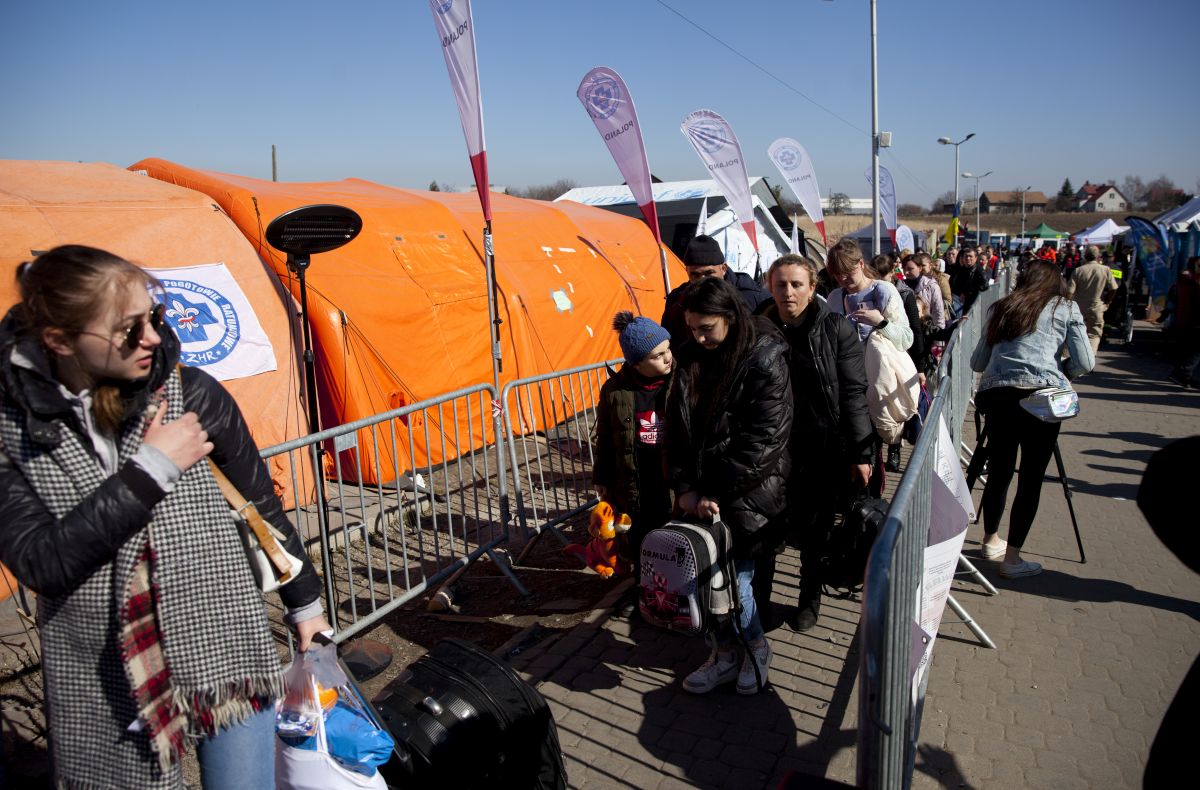Refugees from Ukraine Adapting to the European Labour Market
Due to the length of the war in Ukraine, more and more refugees from this country have decided to take up employment in the EU. Preliminary data indicate that they are integrating into European labour markets faster than refugees from other regions. However, the mismatch between their jobs and qualifications remains a challenge. Despite the refugees’ inclusion, the deteriorating economic situation in Europe may lead to negative perceptions in host countries.
.jpg) Marek Lapis / Forum
Marek Lapis / Forum
Since March 2022, a total of around 4 million people fleeing the war have registered for temporary protection in EU countries. Most of them, a total of about 3.8 million, received protection in Poland and Germany. The report published by the European Asylum Agency (EUAA) shows that the choice of destination country by refugee was determined primarily by the possibilities of finding a job (50% of indications) and family or friendship connections (47%). A survey by the EU Agency for Fundamental Rights (FRA) conducted in August and September 2022 in the 10 EU countries hosting the most refugees, published in February 2023, shows that 35% of the refugees over the age of 16 planned to return to Ukraine and 38% preferred to stay in their host country.
Socio-Economic Conditions of Integration in the EU
The shortage of workers in European labour markets has created favourable conditions for the integration of Ukrainian refugees. These markets, which have been struggling for years with a shortage of native workers, were confronted with a decline in migration caused by the COVID-19 pandemic. During this period, the number of first EU residence permits issued to foreigners fell from around 3 million to 2.3 million per year (in 2019-20), only in 2021 approaching the pre-pandemic level again.
According to Eurostat, at the beginning of the Russian invasion of Ukraine in February 2022, the unemployment rate in the EU was 6.2%. In the Member States to which refugees mainly flowed, it was lower than the EU average—in Poland, it was only 2.8%, in Germany, 3.1%, and in Czechia, 2.5%. Despite the unprecedented scale of refugees from Ukraine, as well as the economic slowdown in the EU resulting from both the pandemic and rising energy prices, labour markets in the EU remain absorptive. At the end of 2022, the unemployment rate in the EU was 6.1%, including 2.9% in Poland, 2.9% in Germany, and 2.3% in Czechia.
Despite the favourable situation on the labour markets, the effects of the war are becoming increasingly felt by Europeans. In a Eurobarometer survey from autumn 2022, almost 65% of EU citizens assumed that their lives would change because of the war. The greatest threats identified by the respondents were the rising cost of living (93%) and poverty and social exclusion (82%). Although there are no pan-European surveys on the impact of these concerns on the public perception of refugees from Ukraine, research conducted in Poland by the University of Warsaw in January 2023 reveals the occurrence of dissonance in the positive attitudes. While most of the respondents declared a positive attitude towards refugees, 25% of them indicated that their attitude towards refugees had changed in the last six months. Of the latter, 68% declared a deterioration in attitude.
EU Support for Integration
Under the Treaty on the Functioning of the EU, the Member States retain the competence for the integration of migrants. The EU can only establish measures to encourage and support the members in this regard.
Taking advantage of this possibility, the European Commission (EC) published a recommendation on the recognition of the academic and professional qualifications of people fleeing the invasion at the beginning of April 2022, and in mid-June last year issued guidelines to facilitate refugees’ access to employment in the EU. In its recommendations, the EC encouraged countries to raise awareness of career guidance and protection against discrimination. support the integration of refugees by, for example, encouraging them to register with public employment services or by providing support to employers employing refugees, opening up markets to refugees as widely as possible, and recognising existing competences and investing in new skills for refugees. To help achieve these objectives, the Commission enabled the countries to use additional EU funds, including the European Social Fund, the European Regional Development Fund, the Fund for European Aid to the Most Deprived, and the Asylum, Migration and Integration Fund.
In October 2022, the EC launched a programme called EU Talent Pool–Pilot to facilitate the professional integration of people registered for temporary protection in the EU. It allows refugees to create and share CVs with verified EU employers on the EURES portal of the European network of employment services.
Socio-Economic Profile of Refugees
According to EC data, women (47%) and children (34%) were predominant among those fleeing Russian aggression in Ukraine to the EU. Although there is a lack of complete administrative data on this subject, surveys conducted by the EUAA and the OECD indicate that the majority of adult refugees from Ukraine have higher-than-average education both for the general population of Ukraine and other groups of refugees in the EU. As much as 71% of Ukrainian refugees declared that they have a university degree, and most of them have a master’s degree or higher. Knowledge of English is also relatively common—half of the refugees surveyed declared the ability to use it. Knowledge of local languages is weaker, with indicators looking more favourable in relation to Slavic languages. For example, in Poland, as much as 38% of the Ukrainian refugees declared knowledge of Polish, while in Germany only 4% had proficiency of German. Various studies on work experience indicate that the vast majority (77% in the EUAA and OECD survey) of adult refugees were economically active (mostly full-time) before moving to the EU.
Results of Integration into the Labour Market
According to the EUAA and OECD reports, in many EU Member States the employment rate of Ukrainian refugees of working age already exceeds 40%, including in the Netherlands, Denmark, and the Baltic States. Taking into account short-term contracts and informal work, similar indicators are also recorded in Poland and in Czechia. Although they are lower in other Member States (e.g., in Spain, according to various estimates, they are in the range of 18-38%), the level of employment of refugees is constantly increasing. The OECD noted that, in the case of immigrants from other regions, it takes about five years on average to achieve the same level of labour inclusion as in the case of refugees from Ukraine.
Ukrainian refugees’ job searches are supported by networks of contacts with compatriots living in the EU before the invasion, as well as national employment agencies and websites with job advertisements created by them. The problem is the mismatch between jobs and the skills of employees: when taking up employment in the EU, refugees from Ukraine have so far been guided primarily by availability, which in many cases resulted in taking up work below their qualifications. Due to the need to combine work with childcare, it is common practice to take up part-time employment.
In the FRA survey, among the barriers to finding a job, the refugees from Ukraine most often indicated a lack of knowledge of the language of the host country, especially in Germany and Spain, at 67% and 65%, respectively. Additionally, 28% of respondents indicated the need to take care of relatives as the main barrier to finding a job.
Conclusions and Perspectives
In conditions of low unemployment and the high socio-economic potential of refugees, the opening of European labour markets to people fleeing the war in Ukraine allowed them to quickly become professionally active in the EU. While many Member States have stepped up their efforts to increase the availability of language training and improve procedures for recognising refugee qualifications, further progress is needed. It will accelerate the integration of refugees and better exploit their potential for the needs of national labour markets, for example in healthcare or the education sector.
Available data on the integration of refugees have so far had a positive impact on their perception in host societies. However, the protracted conflict and the deteriorating economic situation in Europe may weaken it. In this context, it is worth extending integration activities to other, non-economic areas, including social and cultural. At the same time, the experience of the integration of Ukrainian refugees into the labour markets of the Member States should be used in relation to other groups of refugees in the EU, for example through a wider opening of national markets to them.





